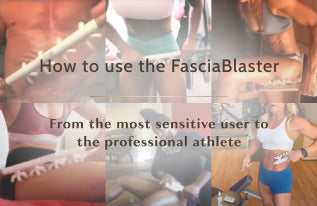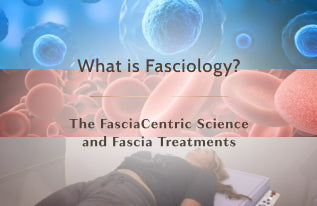The Discovery of a new fascial Cell, The FasciaCyte
FasciaBlasting, the Fasciacyte, & the Fascial System

In 2018, at the Fascia Congress in Berlin, Dr. Stecco, Professor of Anatomy, presented her fascia research with the discovery of a new cell.1 That’s right, in modern medicine, we do not know everything, and we certainly know little about fascia as a system.

What is the Difference Between a Fibroblast and a Fasciacyte
To expand on the definition of a fibroblast, it was basically believed, before this discovery, to produce fascia or Extracellular Matrix ECM. Fibroblasts also release collagen fibrils, enzymes, elastin, and growth factors. Bear in mind that the fascia definition is still evolving. In fact, when I hear words like matrix or XYZ “substance,” I realize that the people writing the books literally had no idea what they were talking about. Like,” It looks like a spider web, so let’s call it arachnoid mater,” or “it is something we don’t recognize, so we will just call it substance.” The closer you look at cellular biology, the more you will realize we missed the forest while studying and naming the trees.

Some people use the word fascia interchangeably with the term Extracellular Matrix. But even this generalization doesn’t sit well with me. I would personally argue that fascia is extra and intracellular - but that’s for another blog and that fascia needs a better definition in medical textbooks. Other things that are called fascia, like retinaculum, aponeurosis, membranes, etc., should be given their proper fascia title- because that would provide us with a more accurate picture of human biology. #rantover #for now.

But for the sake of this blog, Fibroblast, in essence, produces the ECM's structural proteins (e.g., fibrous collagen and elastin), adhesive proteins (e.g., laminin and fibronectin), and ground substance (e.g., glycosaminoglycans, such as hyaluronan and glycoproteins) - or so we thought. In general, fibroblasts are known as sort of the "fix it committee" for the fascia, playing a role in wound healing and mediators that prevent fibrosis.3
So, where did we go wrong? In the assumption that the fibroblast produced the hyaluronan or hyaluronic acid. So why is hyaluronic acid important? According to Harvard Medical Journal, hyaluronic acid is a “humectant — a substance that retains moisture — and it is capable of binding over one thousand times its weight.” It’s a sponge, which I have extensively discussed in the What is Fascia Part 1 and Part 2 blogs. It’s also what gives fascia glide, i.e., movement.1

So, to wrap it up, hyaluronic acid lubricates the fascia, giving it the ability to glide and absorb nutrients to deliver to cells. AND that this is not performed by the fibroblast; it’s performed by our new friend - the FasciaCyte. How cool!
What is the Impact of the FasciaCyte on Our Understanding of FasciaBlasting, Myofascial Release, and Other Manual Therapy?
Okay, people, here’s where things get interesting. So we know that Fibroblasts produce the more structural stuff of the fascial web and that FasciaCytes produce the more viscous and liquid part of fascia, but what accelerates this process?

According to the Fascia Congress1, the “Fasciacytes are stimulated by shear while the fibroblasts respond to load and stretch.” So, they are antagonists. This tremendously impacts TREATING fascia because you would want to use techniques to stimulate both the fibroblasts and the fasciacytes.
1. For FibroBlast - load and stretch
2. For FasciaCytes - shearing
So, what do these terms mean in physics?
Load
The overall weight to which a structure is subjected to
Stretch
A lengthening of
Shear
A pulling apart

I want to note that all of this relates to how the FibroBlasts and FasciaCytes are stimulated. This doesn't consider the fascia's electrical or cell transmission component - piezoelectrics. It also doesn't consider that fascia is made primarily of water, which stores information in crystals. Which is a whole other blog... But I still think in terms of how fascia signals to regenerate, it is rooted in the FibroBlast and FasciaCyte.
In short, if the fascia treatment's goal is to stimulate the proliferation or regeneration of fascia, then the techniques that stimulate the FibroBlast and FasciaCytes are your go-tos. FasciaBlasting* is at the top of the list, and here’s why.

How Does this New Knowledge Relate to FasciaBlasting
Simply put, the technique of FasciaBlasting does all 3: Load, Stretch, and Shearing.
By pressing the FasciaBlaster down into the tissue, you are applying load. Blasting on bare skin with oil, the claws pull the tissue in the blasting direction, stretching them and FasciaBlaster shears the fibers by separating them.
I have always wondered precisely WHY? the FasciaBlaster techniques* were so effective for remodeling5 fascia tissue, and this understanding is a good differentiator for FasciaBlasting. It is the only tool that works this way.

Pressure when you press

Stretching as you blast with the muscle fibers and fascia fibers

And shear when you penetrate between muscles fibers and create separation
Also, our nugget tips of the FasciaBlasters shear, load, and stretch at the deeper levels, reinforcing this principle even more.

Why FasciaBlast? Does it Work?
In closing, I want to say that I love FasciaBlasting so much because it takes a very complex science and decades of treatment protocol inventions - and just makes it simple.
‘I always say - when in doubt, blast it out!”
Fasciologists know that fascia requires regular care. Brush your hair, brush your teeth, brush your fascia.
Even though I had a wonderful career with professional athletes and celebrities flying me all around the world, I wanted to ensure that everyone could FasciaBlast themselves and that anyone could afford to care for their fascia*. So, I recommend the FasciaBlaster to the masses - all blasting is good blasting when performed correctly. And if you really want to harness the power of FasciaBlaster instruments, take a course and learn the highly skilled techniques that will impact your patients' lives.

The Best Way To Know If The FasciaBlaster Really Works is to try
our Currated Kit for Beginner
Cited Works
1. The discovery of a new cell at the 2018 Fascia Research Congress in Berlin
2. Fibroblasts: origins, definitions, and functions in health and disease - PMC
3. Fibroblasts in fibrosis: novel roles and mediators - PMC
4. The hype on hyaluronic acid - Harvard Health
* The FasciaBlaster tools have not been cleared by the FDA for the treatment of fascia
Ashley Black, Inventor Of The Fasciablaster

Ashley Black is a decorated inventor, thought leader, and entrepreneur. She is best known for her work in the field of Fasciology. Fasciology is the study of the system of the body called fascia. Fascia is publicly known as the connective tissue, or web, that holds our body together, but fascia is also the viscous system that surrounds and feeds every cell in our bodies. Her work is directly related to the regeneration of this system of the body and the astounding effects this process can have on beauty, sports performance, and medical conditions.
She is best known for inventing instrument-assisted fascia techniques and tools, commercially known as FasciaBlasters. The tools entered the marketplace in 2014 and have become a household product. Black was the first person to write a #1 National Best Selling book about fascia, and she was the first person to do a TED Talk on fascia. By 2017-2018, her innovations and perseverance were rewarded with the American Business Association Stevie Award for Entrepreneur of the Year. IAOPT also awarded her with the Inventor of the Year. She also hit Inc's Fastest Growing Companies in America for the first time. This era was wrapped up with Ashley's self-reported highest accomplishment to date: the peer-reviewed Medical Publication of Research proving that FasciaBlasters can regenerate fascia tissue.
Since then, Ashley has received several awards, beginning with a second #1 National Best Selling Book about the struggles of females in business and authenticity in branding. She also received two global Stevie Awards from the International Business Association: Woman of the Year and a Lifetime Achievement Award for Consumer Goods.
In 2022, Ashley founded The Fascia Advancement Academy and the Fascia Advancement Charity to teach bodyworkers Fasciology. She has hit Inc's Fastest Growing Companies list for a second time, with over $150MM in revenue, profitable and growing. She boasts over 9 million social media followers and over 1 trillion unique media impressions for her work.





